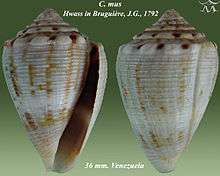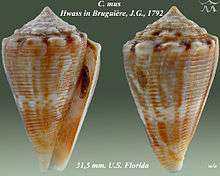Conus mus
| Conus mus | |
|---|---|
 | |
| Apertural and abapertural views of shell of Conus mus Hwass in Bruguière, J.G., 1792 | |
 | |
| Scientific classification | |
| Kingdom: | Animalia |
| Phylum: | Mollusca |
| Class: | Gastropoda |
| Clade: | Caenogastropoda |
| Clade: | Hypsogastropoda |
| Clade: | Neogastropoda |
| Superfamily: | Conoidea |
| Family: | Conidae |
| Genus: | Conus |
| Species: | C. mus |
| Binomial name | |
| Conus mus | |
| Synonyms[1] | |
| |
Conus mus, common name the mouse cone, is a species of sea snail, a marine gastropod mollusk in the family Conidae, the cone snails and their allies.[1]
Like all species within the genus Conus, these snails are predatory and venomous. They are capable of "stinging" humans, therefore live ones should be handled carefully or not at all.
Distribution
This species occurs in the Caribbean Sea and the Gulf of Mexico; in the Western Atlantic from North Carolina, USA and the Bermudas to Venezuela.
Description
The maximum recorded shell length is 43.5 mm.[2] The shell has a tubercuiated spire. The body whorl is covered by narrow, raised revolving striae. Its color is ash-white, longitudinally streaked and maculated with chestnut. The tubercles of the spire are white, and there is usually a white band below the middle of the body whorl. The aperture is chestnut-colored, with a central white band.[3]
Habitat
Minimum recorded depth is 0 m.[2] Maximum recorded depth is 18 m.[2]
References
- 1 2 Conus mus Hwass in Bruguière, 1792. Retrieved through: World Register of Marine Species on 27 March 2010.
- 1 2 3 Welch J. J. (2010). "The "Island Rule" and Deep-Sea Gastropods: Re-Examining the Evidence". PLoS ONE 5(1): e8776. doi:10.1371/journal.pone.0008776.
- ↑ G.W. Tryon (1884) Manual of Conchology, structural and systematic, with illustrations of the species, vol. VI; Philadelphia, Academy of Natural Sciences
- Bruguière, [J.-G.] 1792. Encyclopédie Méthodique. Histoire Naturelle des Vers. Encyclopédie Méthodique. Histoire Naturelle des Vers 1: 345-757. Panckoucke: Paris.
- Tucker J.K. & Tenorio M.J. (2009) Systematic classification of Recent and fossil conoidean gastropods. Hackenheim: Conchbooks. 296 pp.
- Puillandre N., Duda T.F., Meyer C., Olivera B.M. & Bouchet P. (2015). One, four or 100 genera? A new classification of the cone snails. Journal of Molluscan Studies. 81: 1-23
Gallery
 Conus mus Hwass in Bruguière, J.G., 1792
Conus mus Hwass in Bruguière, J.G., 1792 Conus mus Hwass in Bruguière, J.G., 1792
Conus mus Hwass in Bruguière, J.G., 1792 Conus mus Hwass in Bruguière, J.G., 1792
Conus mus Hwass in Bruguière, J.G., 1792
External links
| Wikimedia Commons has media related to Conus mus. |